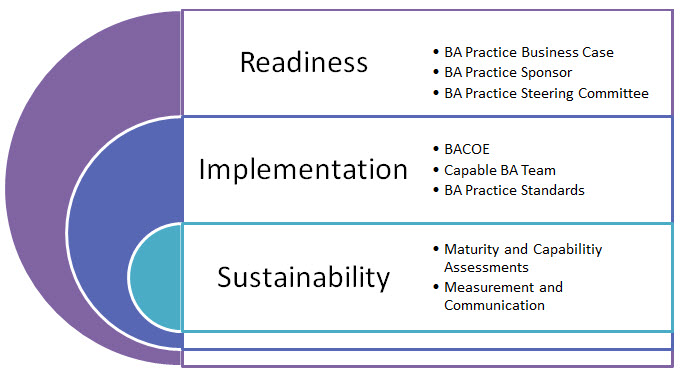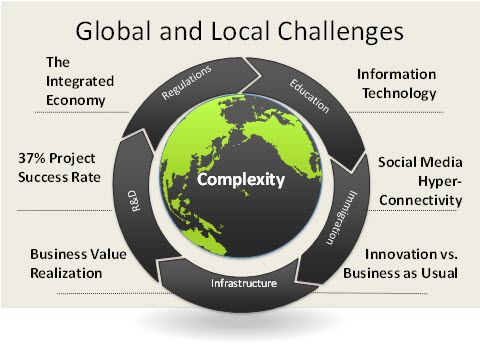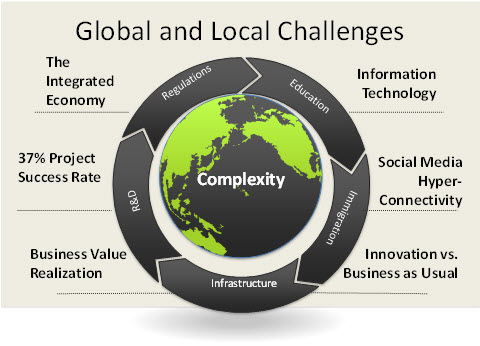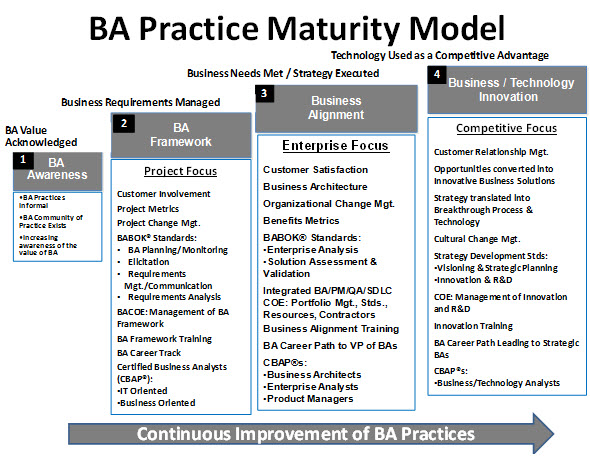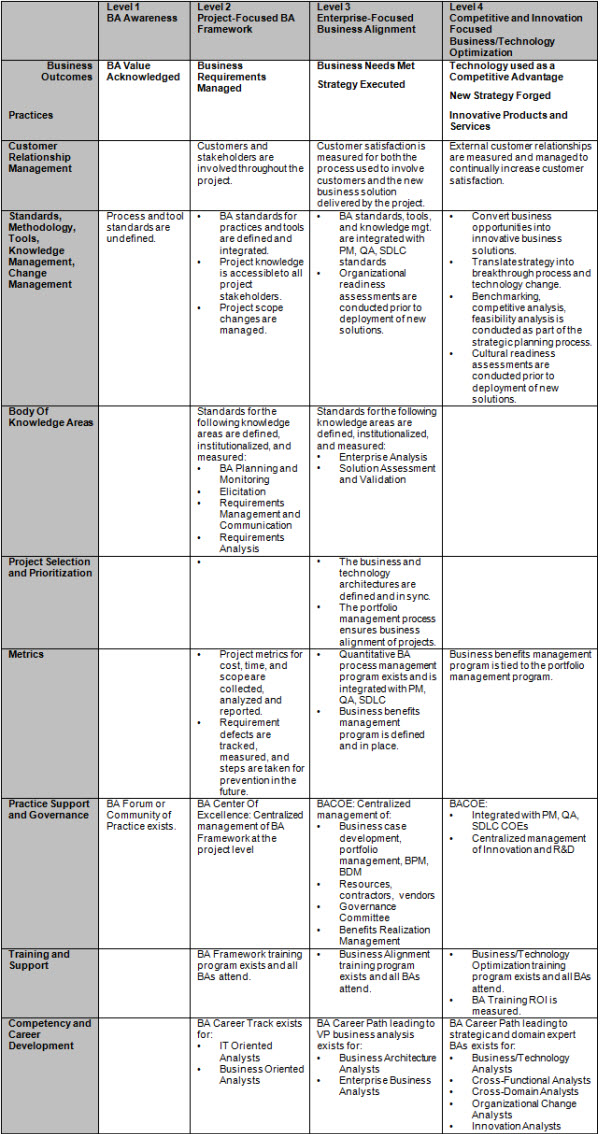The BA Practice Lead Handbook 5 – Getting Organized. What Structure is Right for You During the Start-up Phase?
A center of excellence is a team of people that is established to promote collaboration and the application of best practices. Centers of excellence are emerging as a vital strategic asset to serve as the primary vehicle for managing complex change initiatives.
Centers of excellence exist to bring about an enterprise focus to many business issues, e.g., data integration, project management, enterprise architecture, business and IT optimization, and enterprise-wide access to information. The concept of centers of excellence (COE) is quickly maturing in twenty-first century organizations because of the need to collaboratively determine solutions to complex business issues. Project management offices (PMO), a type of COE, proliferated in the 1990s as a centralized approach to managing projects in response to the challenges associated with complex projects in an environment with low levels of project management maturity and governance.
Business Analysis Centers of Excellence
The business analysis center of excellence (BACOE) then, is an emerging best practice, a new type of center which serves as the single point of contact for business analysis practices. In that role, the BACOE defines the business rules, processes, knowledge, skills and competencies, and tools used by the organization to perform business analysis activities throughout the project life cycle, from strategic planning to project initiation to solution delivery and benefits realization.
As the discipline of business analysis becomes professionalized, it is no surprise BACOEs are quickly emerging. Staffed with knowledgeable business and IT team members, these centers are fulfilling a vital need in organizations today – providing a business-focused home for current business analysis practices, technologies, and emerging trends. The BACOE serves as an internal consultant and information broker to both the project teams and to the executive management team. In addition, the BACOE is responsible for continuous improvement of business analysis practices. To that end, the BACOE continually evaluates the maturity of business analysis and implements improvements to overall business analysis capability.
Implementing the BACOE
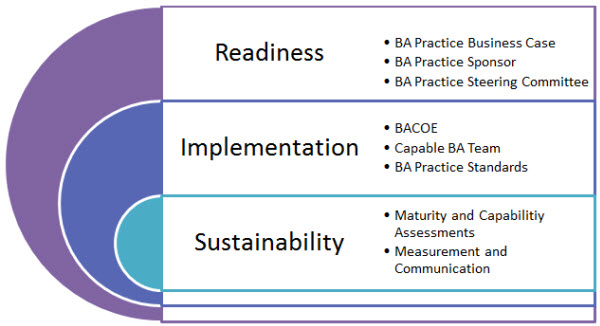
Referring again to the BA Practice Framework, we assume you have completed the Readiness Phase, and are now ready to begin to implement the BACOE.
There are several models of BACOEs that are in existence today. Each structure has unique composition, goals and outcomes. The type of center that is most appropriate for your organization depends heavily on the culture, power and politics that exist within your organization. Common BACOE structures include those described in the table below.
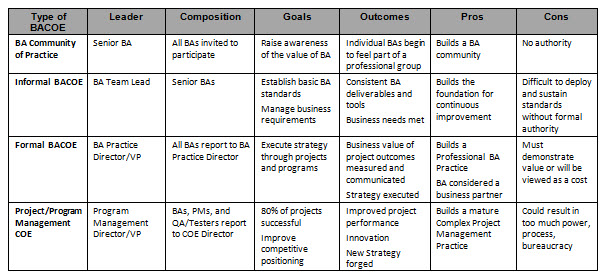
BACOE Scope
A truly comprehensive BACOE is broadly scoped to include the services, functions, tools and metrics needed to ensure the organization invests in the most valuable projects, and then delivers the expected business benefits from project outcomes in terms of value to the customer and/or wealth to the organization. A full-service BACOE typically performs the functions described below.
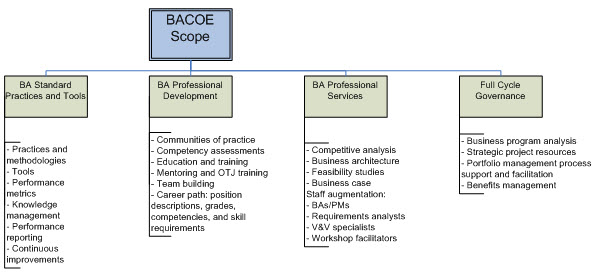
A fully functioning BACOE is capable of providing services across the gamut of business analysis practices. The BACOE mission and objectives are met through training, consulting and mentoring business analysts and project team members, by providing BA resources to the project teams, by facilitating the portfolio management process, and by serving as the custodian of BA best practices. The BACOE generally performs all or a subset of the following services.
• BA Standard Practices and Tools – provides standard business analysis practices
-
- Methods – defines the methodology, metrics and tools for use on all strategic projects within the organization.
- Knowledge management – maintains the central historical data base of business analysis standard tools, processes and business architecture components
- Continuous improvement – periodically evaluates the maturity of the business analysis practices within the organization, and implements improvements to policies, processes, tools and procedures
• BA Professional Development – provides professional development for business analysts
-
- BA career path – along with the Human Resources Department, designs and maintains the BA competency model including titles, position descriptions, functions
- Coaching and mentoring – provides mentoring services to BAs and project teams to help them meet the challenges of their current project
- Training and professional development – provides formal skills and knowledge assessments, and education and training for the professional development of BAs
- Team building – provides team building experiences to project managers, business analysts, and team members
• BA Professional Services – serves as a group of facilitators and on-the-job trainers who are skilled and accomplished business analysts to provide business analysis consulting support including:
-
- Conducting market research, benchmark and feasibility studies
- Developing and maintaining the business architecture
- Preparing and validating the business case
- Eliciting, analyzing, specifying, documenting, validating, and managing requirements
- Managing requirements verification and validation activities, e.g., the user acceptance test
- Preparing the organization for deployment of a new business solution
- Providing resources to augment project teams to perform business analysis activities that are under-resourced or urgent
• Full Cycle Governance – promotes a full life-cycle governance process, managing investments in business solutions from research and development to operations. Provides a home (funding and resources) for pre-project business analysis and business case development.
-
- Business program management – works with management and the portfolio management team to implement a twenty-first century model that transitions organizations from stand-alone IT project management to business program management.
- Strategic project resources – provides senior-level business analysts to lead the business analysis effort for strategic initiatives.
- Enterprise analysis – provides process coordination and meeting facilitation to the portfolio management team. Conducts enterprise analysis activities and prepares the project investment decision package consisting of the business case, the results of studies and other supporting information that provides senior management with a clear understanding of what business results are to be achieved through a major investment.
- Benefits management – Measures the business benefits achieved by new business solutions; facilitates the adoption of a shared vision of the benefits realization process, manages the investment throughout the project life cycle and after the solution has been delivered.
Putting it all Together
So what does this mean for the Business Analyst?
Today’s BAs are performing their duties in a myriad of organizational environments. Determine where your organization is on the continuum and get involved in moving your BA practice to the next level.
So what does this mean for the BA Practice Lead?
This article presents the case for a BA Practice Lead to examine the organization to determine the best fit for the BACOE. Perhaps a less formal COE is appropriate at this point in time to build the foundation and credibility needed to implement a formal BACOE. Leverage the existing structures and power bases to launch your BACOE, constantly demonstrating the value of a mature BA practice.
Parts of this article are adapted with permission from The Business Analysis Center of Excellence, The Cornerstone of Business Transformation by Kathleen B. Hass, PMP, Richard Avery, Terry Longo, and Alice Zavala. © 2007 by Management Concepts, Inc. All rights reserved.
Don’t forget to leave your comments below.
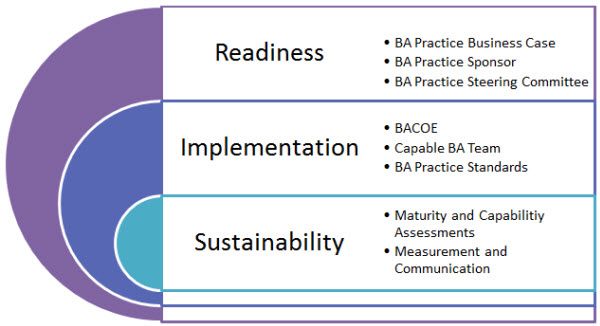
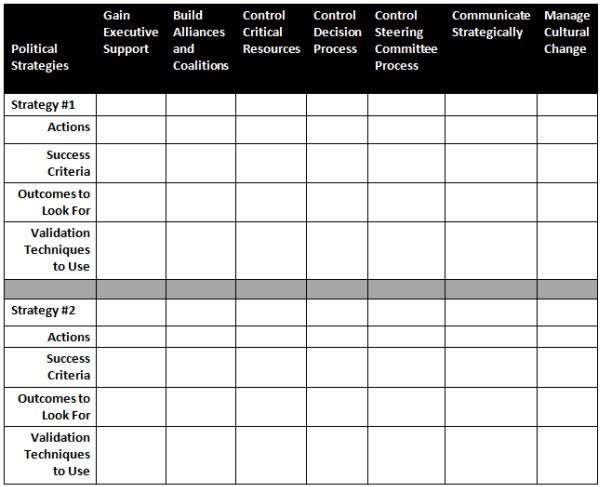
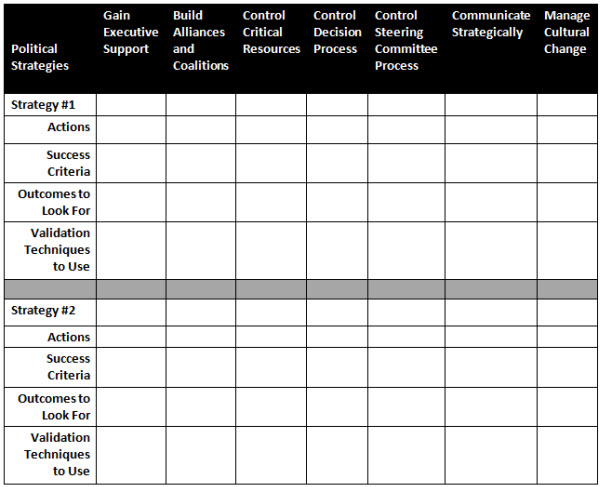


 In the previous articles, we discussed the reasons Business Analysis (BA) is emerging as a critical business process, and the value of Enterprise BAs. However, organizations are experiencing lots of challenges attempting to implement an effective BA Practice. In this article, we will examine some of the fundamental building blocks that will enable you to be successful in creating and sustaining a mature BA Practice.
In the previous articles, we discussed the reasons Business Analysis (BA) is emerging as a critical business process, and the value of Enterprise BAs. However, organizations are experiencing lots of challenges attempting to implement an effective BA Practice. In this article, we will examine some of the fundamental building blocks that will enable you to be successful in creating and sustaining a mature BA Practice.